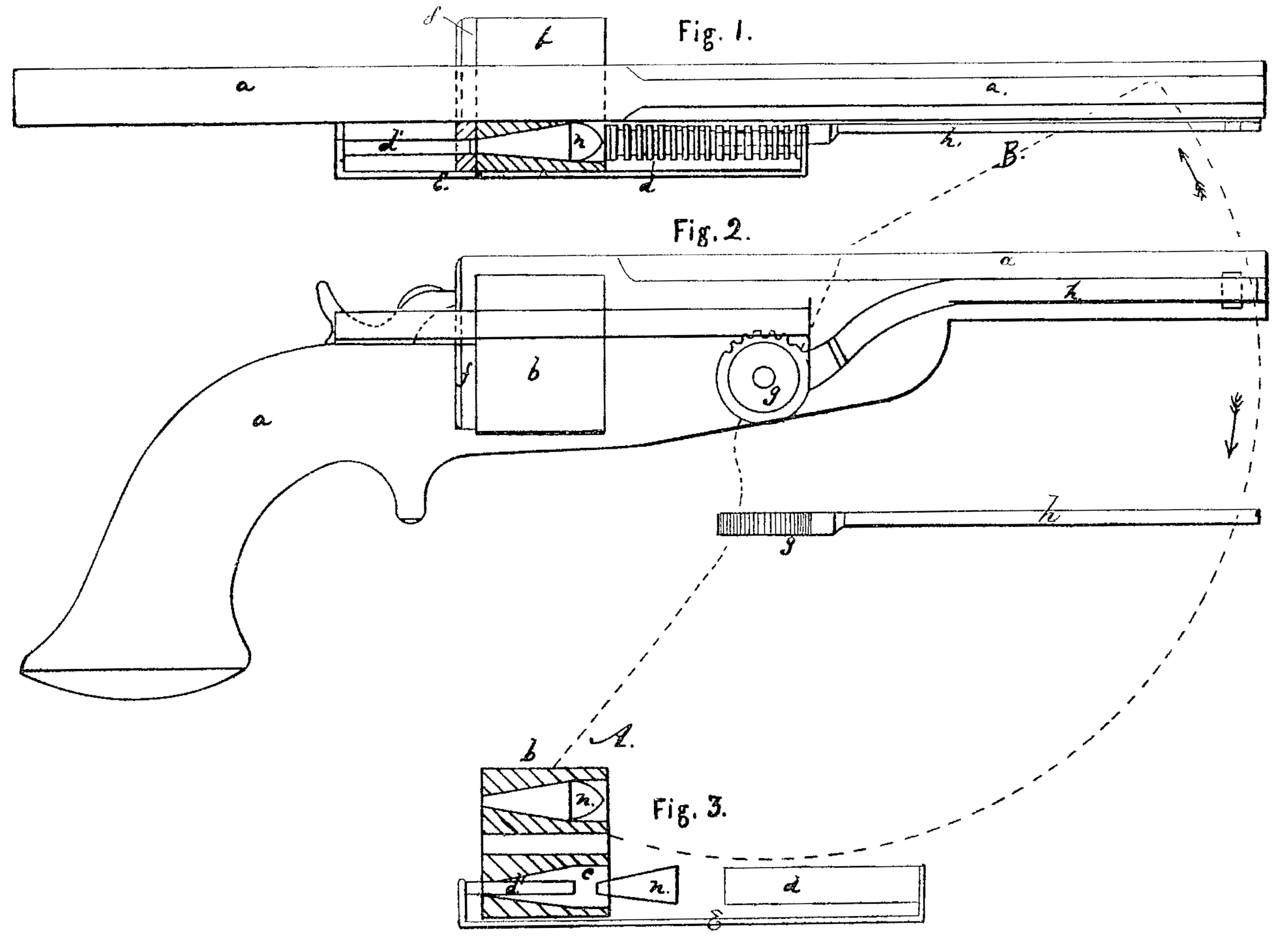US 40553
UNITED STATES PATENT OFFICE.
JOHN WEBSTER COCHRAN, OF NEW YORK, N.Y.
IMPROVEMENT IN REVOLVING FIRE-ARMS.
Specification forming part of Letters Patent No. 40,553, dated November 10, 1863.
To all whom it may concern:
Be it known that I, John Webster Cochran, of the city, county, and State of New York, have invented new and useful Improvements in Revolving Fire-Arms; and I do hereby declare that the following is a full, clear, and exact description of the same, reference being had to the accompanying drawings, forming part of this specification.
My invention consists—
First, in using double or two rammers or pistons worked by one lever for loading or ramming the cartridge home. After it has been fired the blank shell of the cartridge is removed out of the front of the chamber by the reverse motion of the lever. When in this position the rammers are ready to reload the chamber.
Second, in constructing conical chambers from the front of the cylinder toward the base, leaving a small hole at the center to admit the point of the hammer to strike the conical point of the cartridge, and also to allow the small rammer or piston to enter at the base of the chamber and push the blank part of the cartridge out at the front. By this arrangement. there will be no need of ever removing the cylinder from the frame at the breech of the arm, either for loading or removing the blank cartridge or cleaning the piece, which is very important, particularly for revolving pistols when used in the army or navy.
Figure 1 is a plan or bird’s-eye view of a revolving pistol, showing a part of the cylinder in section, made after my invention. Fig. 2 is a side view or elevation of the same parts out of sight, as shown in red lines; Fig. 3, detail views of the parts for loading and removing the blank cartridges, also the cylinder shown in section with the cartridge in the chamber.
Similar letters of reference indicate corresponding parts in the several figures.
To enable others skilled in the art to make and use my invention, I will proceed to describe its construction and operation.
a, a main part of the pistol; b, cylinder; c, conical chamber for receiving the conical metallic cartridge; d, rammer or piston for loading or ramming the cartridge n into the chamber; d, piston at the rear of the cylinder for removing the blank or shell of the cartridge from the chamber at the front, when the recess in the side of the pistol in front of the chamber is free to receive another cartridge and be forced into the chamber by rammer d. The piston d’, which has pushed the blank out, and being still in the chamber, of course moves back out of the cylinder at the same time the cartridge is going down into the chamber. The pistons d and d are held and moved back and forth by a connecting-bar or yoke, e, attached to the outer ends and passing outside of the cylinder. Rammer d is supported in a dovetailed slot or groove to hold and guide it into the chamber. Piston d is supported at one end by passing through a hole in the recoil-plate f; or it may be held together with yoke e in any convenient manner on the side of the handle or frame of the pistol out of the way of the hand or the working of the lock or cylinder. The rammers and connecting-bar make a kind of sliding frame, moved and worked by a gear-wheel, g, gearing into a rack or teeth made on the piston d, to which is attached lever h for moving the whole backward and forward, and thereby load and unload with one operation of lever h. When the cylinder is ready for firing, the lever h is held at the center of the barrel, and at the front both pistons are out of the chamber and the cylinder is free to turn. The dotted lines indicate the movement the lever h makes to perform its functions in loading and unloading. First, it is moved down in the direction. of the black arrow to A. By this motion piston d is brought back sufficiently to allow the blank cartridge to be thrown out by piston d’, which is of course brought into the chamber and forces the blank out. Then a new cartridge is dropped into the recess in front of the piston d and opposite the chamber. When lever h is moved in the direction of the red arrow, and when it has reached the point at B, the cartridge has been forced home. When lever h is brought back to the center and in line with the barrel then the cylinder is free to turn. This mode of arranging the rammers is particularly intended for the use, of my conical cartridge and chamber; but the same principle could be applied to a revolver that is loaded from the base or back of the cylinder with the common cartridge by changing the pistons and reversing the motion of lever h, that works the loading-rammer from the back and the unloading-piston from the front.
What I claim as my invention, and desire to secure by Letters Patent, is—
The loading and unloading rammers or pistons d and d’, connecting-bar or yoke e, with the gear-lever h, for revolving fire-arms.
J. W. COCHRAN.
Witnesses:
E. P. Bray,
Joseph Minim.

